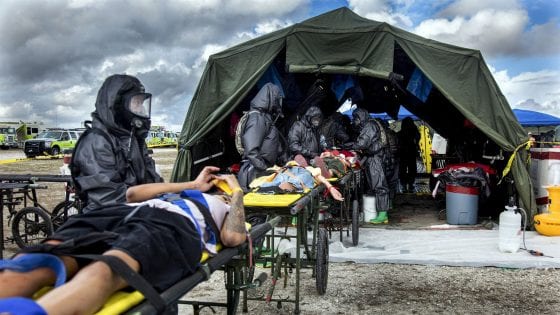The Coronavirus pandemic is a test of leadership like no other. It calls for hard decisions and unconventional solutions.
The first thing to clearly understand is to not treat those who are infected with the virus as a medical problem. This isn’t what your health care system was built for. Don’t let the mistake of thinking because doctors treat illness, they are equipped or trained or stocked with the tools to manage this. They are not. They need to be here to manage the heart attacks, appendicitis, kidney stones etc that they are trained and practiced at treating.
There is no magic wand a doctor can wave or medicines a doctor can prescribe that will reverse the course of this pandemic. They shouldn’t be at the frontlines- you don’t need them to put people on ventilators or start PIC lines. Others can do that. They don’t need to look at a patient or reassure a patient in person- use telemedicine. After they’ve ruled out all the other possibilities- of regular flu, or other illness- they should admit patients to Covid wards- which are NOT in hospitals- and tended by people who are truly well protected.
Isolate the seriously ill, with others who are seriously ill- because we can’t have it anywhere else if we hope to stop it.
 These giant wards should be in convention centers, large warehouses, large temporary structures, school gyms, buildings that are easy to clean, and have only 2 points of entry. A clean entrance where food, supplies are prepared for entry- and a dirty exit where the people and things coming out- are sanitized and sterilized. You don’t use standard disposable PPE gear if you can avoid it- you use a full haz mat suit, and it is sanitized and reused for the next person in. We can’t make enough PPE gear to throw it away multiple times a day in addressing the number of patients.
These giant wards should be in convention centers, large warehouses, large temporary structures, school gyms, buildings that are easy to clean, and have only 2 points of entry. A clean entrance where food, supplies are prepared for entry- and a dirty exit where the people and things coming out- are sanitized and sterilized. You don’t use standard disposable PPE gear if you can avoid it- you use a full haz mat suit, and it is sanitized and reused for the next person in. We can’t make enough PPE gear to throw it away multiple times a day in addressing the number of patients.
If your local fire department doesn’t have a decontamination station, turn to the National Guard, or build one yourself. Take a look at what one looks like.

Decontamination Station Soldiers participate in simulated decontamination operations with mock casualties during a joint training exercise with Miami-Dade County first responders in Miami, Jan. 11, 2018. The soldiers are assigned to the 414th Chemical Company. Army photo by Spc. P.J. Siquig
Does the entry to your hospital look like this? Does the exit? Again, hospitals are for medical conditions, the Coronavirus is a pandemic condition, do not mix or mistake the two. The key is to keep the coronavirus patients somewhere you can manage large numbers of them- using the same gear, and not risking your care providers lives.
People will survive the virus in these facilities- if you are worried about “cross contamination, erect barriers- with sheets, plastic sheeting- the virus can’t travel up on it’s own, and so cross contamination is only from bed to bed by caregivers, and adequate spacing can solve that. It is much easier to clean a mass facility than it is to do individual rooms, nooks and crannies and all.
Reports have come in that in Spain they are filling ice rinks with bodies. You may not have ice rinks. It will become an issue, so start trying to find cold storage facilities. You’ll also have to find a way to make 02 for all the ventilators- and patients. It’s going to be critical.
If you don’t keep the virus and your hospital separate, you will be prolonging your battle for no good reason. The biggest problem is people who present with both the corona virus and other emergency medical conditions. That’s where the use of single use PPE comes in. You should also build a separate hospital for these cases- or at least wall off parts of yours to make it work. The Chinese are even opening wards run by robots. Seriously.
Do not count on for profit hospital administrators or public health commissioners to know what to do. This isn’t in their wheelhouse. Ideally, your National Guard has people who have trained for chemical warfare, and have a better understanding on how to manage this.
Until testing supplies become readily available, save your tests for regular admissions and for medical staff, and keep your medical teams small, segregated and tracked. That way if someone does get infected, the loss of resources while they quarantine is minimal.
Please realize, that there is no return back to what was before, we will be in a brave new world once this crisis passes. We may be without a lot of people, and some behaviors may forever be changed. How you choose to lead in your community is up to you, but making hard decisions and following through with them is what will make the difference.
And if you are asking where these ideas came from, or wondering do I have a PhD? Sorry, I’m just a former paratrooper who reads a lot and was trained in unconventional warfare. I hope that’s good enough, or at least you understand that you have to “think different” when the rules change.

I always love the way you think!!!
Your ideas need to be put into action!!
@Leslie- thank you!